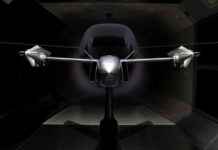The war in Ukraine rages on. But that doesn’t deter an entrepreneur from Kyiv from his goal of bringing an electrically powered vehicle onto the market. In the face of constant power outages, the new E-Luaz can come in very handy.
A Ukrainian company wants to bring an electric car onto the market – and that in the middle of the war. Vadym Ihnatov, a businessman from Kyiv, announced in mid-December the revival of the Soviet-era automobile manufacturer Luaz. The first model, an electrically powered mini pickup, is expected to be launched this year.
With the new Luaz, Ihnatow wants to build on the former success of the Luzker automobile plant – a Soviet model company whose Luaz-966 off-road vehicles built between 1967 and 1990 were very popular in the countries of the socialist camp. After the collapse of the Soviet Union, the plant struggled with economic problems for years until it finally had to stop production in 2006.
“I always thought it was a shame that such an extraordinary car disappeared,” Ihnatow wrote on Facebook in mid-December, referring to the Luaz-966. “That’s why I decided to revive the Luaz brand and start production of a new electric car,” explained the entrepreneur, who is also a board member of the Ukrainian Electromobility Association.
Ihnatow also showed the mini pickup in action on his Facebook page: in two videos, the entrepreneur drifts through the snow-covered landscape in the white car. Luaz Motors, the new company under the old name, plans to start taking pre-orders for the e-Luaz as early as spring. Ihnatow expects to be able to produce up to a thousand vehicles a year – “under favorable conditions,” he adds in an interview with the newspaper “Ukrajinska Pravda”.
It is questionable whether the conditions will be favorable in view of the ongoing war. Nevertheless, Ihnatow is optimistic about the future: “Now more than ever, Ukraine needs an electric car for the masses to solve the problems of post-war reconstruction,” he writes on Facebook. “My expectation is that the main customers will be small farmers or companies that need to transport a large number of small loads,” he points out.
The mini pickup gets a 5 kW motor with a power consumption of 7 kWh per 100 km/h. Since the car belongs to vehicle category LE7, the maximum speed is only 50 kilometers per hour. The price should also be correspondingly low – the basic version should be available from 5100 US dollars (approx. 4700 euros).
After the car was presented, some media asked how Ukrainian the Ukrainian electric car actually is. Some observers noticed that the e-Luaz basically looks almost the same as the EEC L7e vehicle sold on the Chinese marketplace Alibaba. Externally, the two cars differ only in the shape of the front bumper and headlights. So is the “Ukrainian car” not Ukrainian at all?
Ihnatow makes no secret of the fact that his company buys the bodies in China. In an interview with “Ukrainska Pravda”, the businessman adds that they are also sold in the USA, Mexico, Brazil and the United Arab Emirates. “It’s a successful design and the license is being taken out by companies in different countries.” According to Ihnatow, there is currently not a single production facility in Ukraine that can produce metal bodies. The engine comes from China for the same reason: “We couldn’t find a manufacturer in Ukraine”.
But there is also a lot of Ukrainian in E-Luaz: the batteries come from Odessa, battery management systems and charger from Ternopil, as well as the brake system and headlights. A company from Lutsk is to deliver chassis.
In his own words, Ihnatow initially wanted to have other parts made in the Ukraine, but the war thwarted the plans. For example, a rim manufacturer near Kyiv who was supposed to deliver the wheels temporarily stopped production. The tires of the traditional company Rosava would hardly be produced anymore. Despite the ongoing war, the company plans to gradually localize production.
Whether 100 percent Ukrainian or not, the new E-Luaz could not only be used in post-war reconstruction. Especially in view of the Russian attacks on the country’s energy infrastructure and the resulting power outages, the small pickup could already be particularly useful. Because its batteries – depending on the configuration, one to four can be installed – not only offer a range of up to 80 kilometers. You can also easily take them out and use them elsewhere, for example at home. According to Ihnatow, such a battery can also supply an apartment with electricity – for a whole ten hours.















